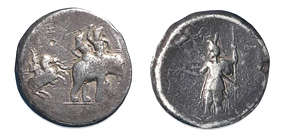
Greco-Macedonian, around 324 BCE
Silver decadrachm
Diameter: 3.1 cm
Weight: 42.2 g
Acquisition number: #CM 1926-4-2-1 (PCG IV.A.4)
Image courtesy of the British Museum (copyright reserved)
While this coin bears no name or date, it is generally believed to be the issue of Alexander's mint after his victory over the Hydaspes, King of Porus, a sub-kingdom of Mauryan Empire. On the front side of the coin is the figure of a lancer on horseback, interpreted as Alexander or one of his army, attacking an elephant mounted by two bare-chested warriors, presumably the Indian defenders of Porus.
On the reverse side is a standing figure in Greek armor, Macedonian cloak and Parthian headwear, bearing a spear in one hand and a thunderbolt in the other.1 In the upper left, a flying female crowns the figure with a laurel wreath, a symbol of triumph. This combination of Macedonian, Greek and Iranian elements in a context that celebrates martial victory is the basis for identifying this figure as Alexander the Great. If this identification is correct, then this is the only image of Alexander to survive from his own lifetime.
(1) See the British Museum web page dedicated to this object.